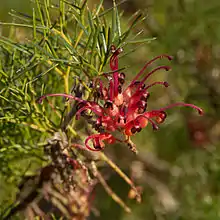Grevillea maxwellii
Grevillea maxwellii is a species of flowering plant in the family Proteaceae and is endemic to the south west region of Western Australia. It is low-lying to spreading shrub divided leaves with linear, sharply-pointed lobes, and clusters of pinkish-orange to pinkish-red flowers with a deep pinkish red style.
| Grevillea maxwellii | |
|---|---|
 | |
| Scientific classification | |
| Kingdom: | Plantae |
| Clade: | Tracheophytes |
| Clade: | Angiosperms |
| Clade: | Eudicots |
| Order: | Proteales |
| Family: | Proteaceae |
| Genus: | Grevillea |
| Species: | G. maxwellii |
| Binomial name | |
| Grevillea maxwellii | |
| Synonyms[1] | |
|
Grevillea asparagoides Meisn. | |
Description
Grevillea maxwellii is a low-lying to spreading shrub that typically grows to 0.2–1.2 m (7.9 in – 3 ft 11.2 in) high and up to 1.5 m (4 ft 11 in) wide. The leaves are 20–75 mm (0.79–2.95 in) long and divided with up to nine lobes, the lower ones usually further divided, the end lobes linear 6–30 mm (0.24–1.18 in) long, 0.8–1.4 mm (0.031–0.055 in) wide and sharply-pointed. The flowers are arranged in clusters on one side of a rachis 25–50 mm (0.98–1.97 in) long and are pinkish-orange to pinkish-red and hairy with a dark pinkish-red style, the pistil 20–24 mm (0.79–0.94 in) long. Flowering mainly occurs from September to November, and the fruit is a woolly-hairy follicle about 10 mm (0.39 in) long.[2][3]
Taxonomy
Grevillea maxwellii was first formally described by Donald McGillivray in 1986, his description published in New Names in Grevillea (Proteaceae) from specimens collected near the Salt River (now known as the Pallinup River) by George Maxwell.[4] The specific epithet (maxwellii) honours the collector of the type specimens.[5]
Distribution and habitat
This grevillea grows in low heath, often in rocky places and is found in the catchment of the Pallinup River in the Esperance Plains bioregion of south-western Western Australia.[2][3]
Conservation status
Grevillea maxwellii is listed as "Threatened" by the Western Australian Government Department of Biodiversity, Conservation and Attractions,[3] meaning that they are in danger of extinction.[6]
References
- "Grevillea maxwellii". Australian Plant Census. Retrieved 4 July 2022.
- "Grevillea maxwellii". Australian Biological Resources Study, Department of Agriculture, Water and the Environment: Canberra. Retrieved 4 July 2022.
- "Grevillea maxwellii". FloraBase. Western Australian Government Department of Biodiversity, Conservation and Attractions.
- "Grevillea maxwellii". APNI. Retrieved 4 July 2022.
- Sharr, Francis Aubi; George, Alex (2019). Western Australian Plant Names and Their Meanings (3rd ed.). Kardinya, WA: Four Gables Press. p. 249. ISBN 9780958034180.
- "Conservation codes for Western Australian Flora and Fauna" (PDF). Government of Western Australia Department of Parks and Wildlife. Retrieved 4 July 2022.
